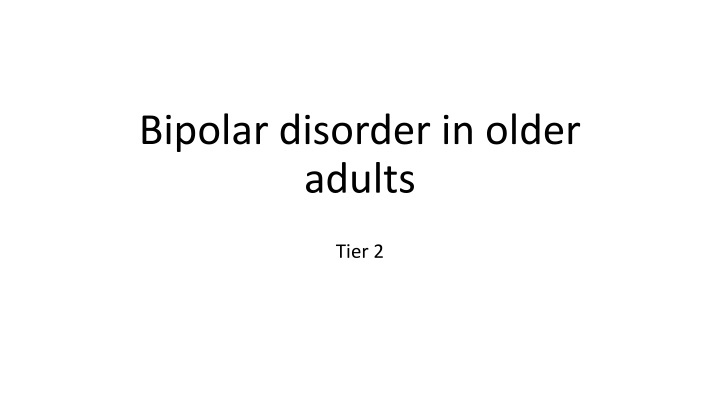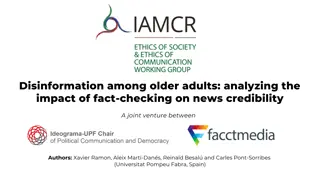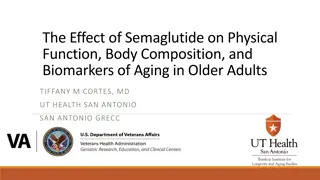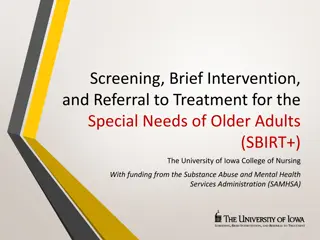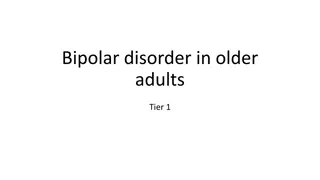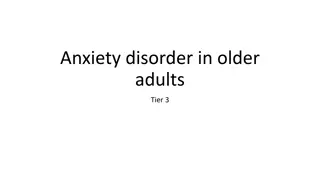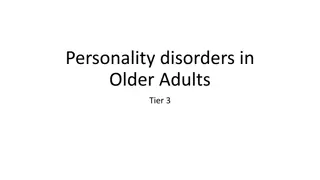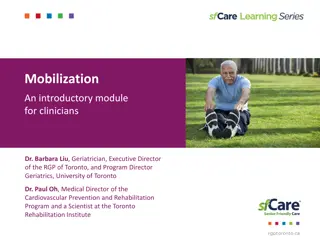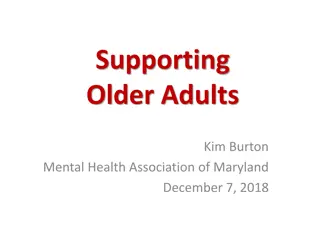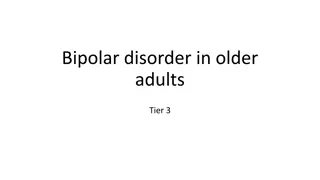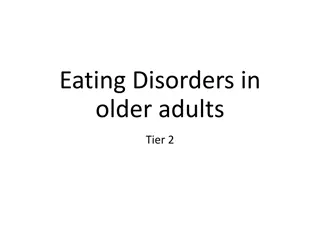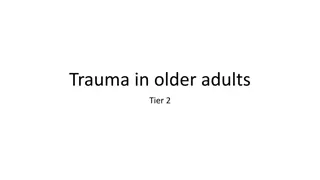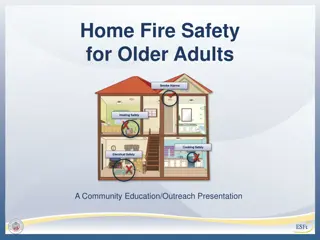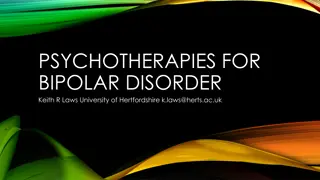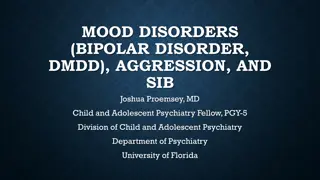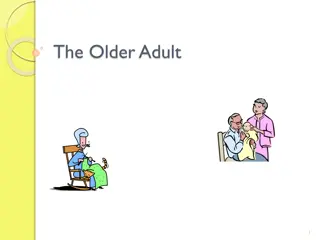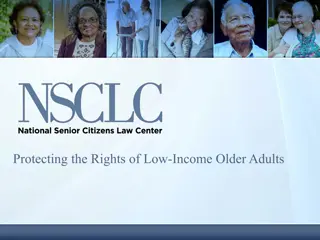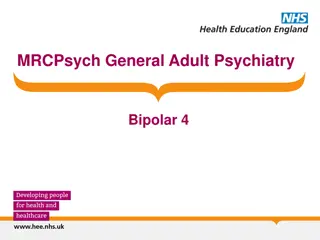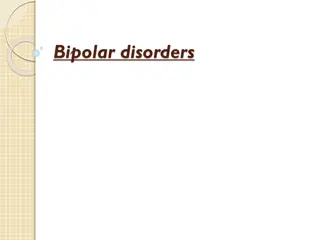Bipolar Disorder in Older Adults
Bipolar disorder in older adults is characterized by episodes of mania and depression. Symptoms vary, and differential diagnosis is essential to differentiate from other conditions. Late-onset bipolar disorder has distinct features compared to early-onset, impacting the individual's health and well-being as they age.
Download Presentation

Please find below an Image/Link to download the presentation.
The content on the website is provided AS IS for your information and personal use only. It may not be sold, licensed, or shared on other websites without obtaining consent from the author.If you encounter any issues during the download, it is possible that the publisher has removed the file from their server.
You are allowed to download the files provided on this website for personal or commercial use, subject to the condition that they are used lawfully. All files are the property of their respective owners.
The content on the website is provided AS IS for your information and personal use only. It may not be sold, licensed, or shared on other websites without obtaining consent from the author.
E N D
Presentation Transcript
Bipolar disorder in older adults Tier 2
Bipolar disorder Characterised by episodes of mania interspersed with episodes of depression. Older adults can also present with recurrent depressive episodes followed by episode of mania. Older adults can have a pre-existing diagnosis of bipolar disorder or they may present with late onset bipolar disorder. Research suggests that late onset bipolar disorder usually presents after the age of 50 years. It is more common in females than males. Older adults can present with functional and cognitive impairment which means the diagnosis can be missed.
Symptoms Symptoms of mania can include Excessive energy Inability to sleep Racing thoughts Pressured speech Inability to concentrate Delusional thoughts Ideas of high self- importance Hallucinations Excessive spending or reckless behaviour Symptoms of depression can include: Sleep disturbance Fatigue Psychomotor retardation Poor memory Loss of interest Hopelessness Feelings of guilt Suicidal thoughts
Difference between later onset bipolar disorder and early onset bipolar disorder Late onset Bipolar disorder Early onset Bipolar disorder Develops around the age of 50 years or later Usually before the age of 40 years Lower rate of familial illness Higher rate of familial illness Higher rate of neurological and medical morbidity Not associated with higher rates of neurological or medical morbidity Higher rates of relapses Although there are relapses the rates of relapses are not as high as in late onset
Differential diagnosis Early stages of dementia can present with symptoms suggestive of mania such as irritable mood, emotional lability, sleep disturbance, and impaired social judgment Alcohol and drug misuse/ withdrawals Delirium Medications such as steroids, Parkinson s medications, anti- hypertensive medications such as captopril, and antidepressants can precipitate mania Physical causes - thyroid issues including hyperthyroidism, infections, metabolic disturbances, neoplasm, stroke, encephalitis, epilepsy, and toxins can precipitate mania
Impact of having Bipolar disorder on older adults Higher rates of cardiovascular disease Diabetes and Hypertension are more common Higher rates of cognitive issues Symptoms as a result of being on medications eg lithium - tremor of hands Death occurs an average of 10 years earlier than the general population.
Risks to watch out for Wandering risk / going out late in the night or early hours Not eating / drinking - self-neglect Risky behaviour - excessive spending / excessive drinking alcohol Driving Non-compliance with medications including physical health medications Loss of support network due to disorganised / odd behaviour Vulnerability to exploitation Risk of suicide
What to do? Contact the GP immediately for a check up as there can be a number of physical health issues Check the medication packs if they have a known diagnosis of bipolar they may have stopped their medication If at all possible liaise with a family member to check what symptoms they have noticed and to ensure that they are alerted Assess for any risks and ensure that the older person is safe
Treatment Treatment includes referral to an Old Age Psychiatrist Medications including mood stabilisers and anti-psychotic medications can help with regulation of the mood Anti-depressants can be used for depression along with mood stabilisers If they are on Lithium make sure that they have information leaflet about lithium and how physical ill health can impact on lithium levels Serum lithium levels to be monitored Try to reduce any psychosocial stressors Support them with understanding of their illness and need for treatment Psychological therapies can be useful
Monitoring Check medication packs to check for compliance as they may not believe they are unwell .Monitor for side effects of medication. If at all possible liaise with a family member to ensure that they are alerted and know who to call in a crisis Ask the older person about their Sleep - Advise re sleep hygiene Check on their Hydration - Are they drinking enough fluids? Check on their Nutrition - Are they eating enough? Monitor risks -Ensure that the patient is safe
Resources MPC_09_01 - Bipolar Disorder | Bipolar Disorder (mindedforfamilies.org.uk) This is an easy to access website for older adults and their families which has good advice about symptoms and treatment of Bipolar disorder in older adults
